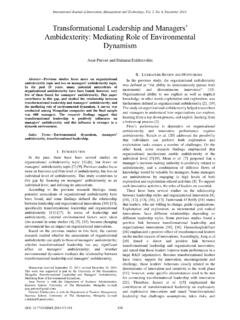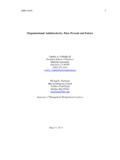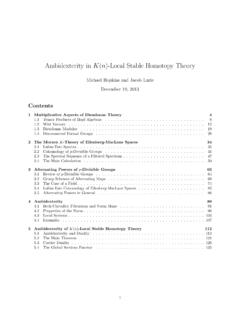Transcription of Innovation through Ambidexterity: How to Achieve the ...
1 1 Innovation through ambidexterity : how to Achieve the Ambidextrous Organization Constantinos Markides London Business School Sussex Place, Regent s Park London, NW1 4SA, United Kingdom Phone: (+44) 20- 7000 8740 Fax: (+44) 20- 7000 7001 E Mail: and Wenyi Chu National Taiwan University 50, Lane 144, Keelung Road, Sec. 4 Taipei, TAIWAN Phone: (+886) 2 2362 5008 Fax: (+886) 2 2362 5379 E Mail: 2 Innovation through ambidexterity : how to Achieve the Ambidextrous Organization ABSTRACT It has long been recognized in the literature that the pursuit of radical or disruptive Innovation by established firms poses an organizational challenge for the firm.
2 This is because the skills, structures, processes and mindsets required for exploiting the existing business are fundamentally different and often conflict with those required for radical Innovation ( exploration). This has led researchers to propose the need for ambidextrous organizations companies capable of achieving efficiency in their existing business while at the same time having the strategic foresight to innovate and explore new businesses. Past research has found some support for a positive relationship between performance and the ability to be ambidextrous. There is, however, little evidence on how a firm can actually Achieve ambidexterity .
3 In this paper, we explore the issue of ambidexterity in the context of diversified firms. Specifically, we examine diversified firms that need to manage divisions that face conflicting demands for integration and responsiveness. Not all divisions of a diversified firm face such conflicting demands, so we focus on only those divisions that do. These divisions must be given autonomy to be locally responsive but must also be centrally controlled to allow for the efficient exploitation of interdependencies with the parent (and other divisions in the diversified firm). We use theory to propose ways by which a diversified firm could Achieve such ambidexterity in its handling of these divisions.
4 We then utilize questionnaire data from the 100 biggest business Groups in Taiwan to empirically test our hypotheses. We find that granting operational autonomy to separate divisions while centralizing strategic and financial controls promotes the achievement of ambidexterity . We also find that ambidexterity could be promoted through the use of strong values, rotation of managers and internal training programs. 3 Innovation through ambidexterity : how to Achieve the Ambidextrous Organization The ability of a firm to exploit its current business while exploring new territory (in terms of new technologies, markets, products or business models) has long been recognized as a critical source of competitive success (Eisenhardt and Martin, 2000; March, 1991; Thompson, 1967; Tushman and O Reilly, 1996; Quinn and Cameron, 1988.)
5 The need to Achieve a balance between these two distinct activities has been proposed in a wide range of management areas, including organization theory ( Holmqvist, 2004), managerial economics ( Ghemawat and Costa, 1993), international business ( Bartlett and Ghoshal, 1989) and strategic management ( Winter and Szulanski, 2001). However, achieving this balance is a central paradox of administration. (Thompson, 1967, ) This is because the skills, mindsets, structures and processes required to Achieve exploitation of the current business are fundamentally different and often conflict with those required to Achieve exploration.
6 For example, in a classic study Burns and Stalker (1961) proposed that organizations developing new products ( exploring) should be organic, whereas organizations engaged in exploiting their existing businesses should be mechanistic. Several other studies have shown that exploration and exploitation require substantially different structures, processes, skills and strategies that appear contradictory and difficult to combine (Benner and Tushman, 2003; Levinthal and March, 1993; March, 1991; Sheremata, 2000; Tushman and O Reilly, 1996). Organizations that are capable of achieving the appropriate balance between exploitation and exploration have been labeled ambidextrous organizations ( Duncan, 1976; Tushman and O Reilly, 1996).
7 Recent studies have empirically tested the relationship between organizational performance and the ability to be ambidextrous and have generally found a positive relationship ( Adler, Goldoftas and Levine, 1999; Ahuja and Lampert, 2001; Benner and Tushman, 2002; Gibson and Birkinshaw, 2004; He and Wong, 2004; McDonough and Leifer, 1983). But whereas 4 the need for and the beneficial effects of achieving ambidexterity have been recognized, little work has been done on exactly how organizations could Achieve ambidexterity . Most authors have viewed the achievement of ambidexterity as a structural issue ( Christensen 1997; Duncan, 1976; Tushman and O Reilly, 2004).
8 For example, Duncan (1976) proposed that organizations Achieve ambidexterity by putting in place dual structures so that certain divisions focus on alignment while others focus on adaptation. Similarly, Christensen and Raynor (2003) proposed that established companies could only pursue a disruptive Innovation in a separate unit, away from the interference of the parent company. O Reilly and Tushman (2004) suggested that ambidextrous organizations create separate units to pursue new opportunities but keep the same general manager to manage both the new unit and the parent company. Recently, attention has begun to shift towards non-structural elements of ambidexterity such as culture and values, incentives, mindsets and strategic foresight ( Adler, Goldoftas and Levine, 1999; Ahuja and Lampert, 2001; Costanzo, 2004; Eisenhardt and Martin, 2000; Gibson and Birkinshaw, 2004; MacKay and McKiernan, 2004; Siggelkow and Levinthal, 2003; Siggelkow and Rivkin, 2005; Volberda, 1996).
9 Our paper builds upon this tradition and proposes several non-structural strategies that firms could pursue in order to Achieve ambidexterity . In other words, over and above creating separate units, what else must a firm do to Achieve ambidexterity ? For the purposes of this research, we take ambidexterity to mean the ability of a firm to simultaneously Achieve decentralization and centralized control. The context of a diversified firm provides a perfect setting to explore this question. This is because the separate units already exist in a diversified firm. Many, though not all, may be pursuing strategies or may be facing external environments that require them to have as much autonomy from the parent as possible (so as to Achieve local responsiveness).
10 But these same units may also need to be integrated with the parent or with other divisions within the portfolio so as to exploit synergies with each other. The question then is: how could the corporate parent provide autonomy to these divisions while at the same time exercising centralized control over them? 5 In this paper, we utilize questionnaire data from the 100 biggest business groups in Taiwan1 to explore how these diversified firms Achieve this kind of ambidexterity . To collect the necessary data, we have administered two questionnaire surveys: one at corporate headquarters and one at division level.









